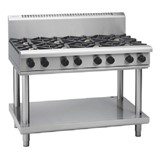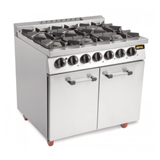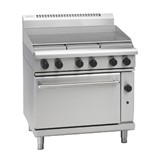Wood-Fired vs. Gas-Fired Pizza Ovens: Which is Best for Your Kitchen?
Making pizza is an art, and the right oven plays a big role in your success. Gas-fired ovens are fast and user-friendly, while wood-fired ovens provide an authentic taste that many pizza lovers crave. In this article, we’ll compare these two types of ovens so you can decide which one is the best choice for your kitchen.
Overview of Pizza Oven Types
-
Wood Fired Pizza Ovens
Wood-fired pizza ovens are traditional cooking devices that use wood as their primary fuel source. These ovens are known for their ability to reach extremely high temperatures, typically up to 900°F (about 480°C), allowing for a unique cooking process. As the wood burns, it creates a rich, authentic Italian wood smoke flavour with a depth of flavour that many pizza enthusiasts cherish.
In addition to making pizzas, wood-fired ovens are versatile and can cook various foods, including meats, fish, and vegetables. They are also excellent for baking bread, providing a rustic and delicious crust. The combination of intense heat and smoke makes wood-fired ovens a favourite for those seeking to replicate the traditional Italian pizzeria experience in their outdoor kitchens.
-
Gas Fired Pizza Ovens
Gas-fired pizza ovens operate using natural gas or propane as their fuel source. These ovens heat up quickly and efficiently, often reaching temperatures of 550°C (about 1,042°F) in just around 25 minutes. This rapid heating capability makes them ideal for busy kitchens where speed is essential without sacrificing quality.
Gas-fired ovens are easier to clean compared to wood-fired ovens. They leave behind minimal ash and residue, making maintenance simpler. Gas ovens also allow for faster pizza preparation, making them a popular choice for home cooks and professional chefs looking for a convenient way to make delicious pizzas.
Cooking Performance
-
Temperature and Cooking Time
Wood-fired pizza ovens are famous for reaching extremely high temperatures, often over 900°F (about 480°C). This intense heat is perfect for cooking Neapolitan-style pizzas, creating a crispy crust and perfectly melted cheese. They can also use radiant heat for lower-temperature cooking, making them great for baking bread and roasting vegetables
Gas ovens can heat up quickly, typically reaching around 550°C (about 1,042°F) in about 25 minutes to maintain consistent temperatures. This is useful during busy cooking times, as it allows you to cook multiple pizzas evenly and efficiently.
-
Flavor and Texture
Wood-fired ovens provide a unique flavor and texture due to the smoky aroma of burning wood. This method creates a delicious, charred crust that many pizza lovers enjoy.
Gas ovens also produce tasty pizzas but without the smoky residue. While they might not have the same depth of flavor as wood-fired ovens, gas ovens deliver consistently good pizzas with a satisfying texture, making them a convenient option for quick and easy cooking.
Convenience and Ease of Use
-
Gas Ovens
Gas ovens offer the convenience of instant heat with a straightforward connection to a gas line. This allows for quick and easy startup, making them very user-friendly. They require minimal prep time before cooking, allowing you to focus more on making delicious pizzas than preparing the oven. Gas ovens are generally easier to operate and maintain, as they don’t leave behind ash or other residues that need regular cleaning.
-
Wood-fired Ovens
-
Wood-fired ovens provide a unique cooking experience but require more preparation and time to start the fire. You must gather and light the wood, wait for it to reach the right temperature, and monitor the fire throughout the cooking process.
-
However, this effort contributes to the rustic look and creates a charming restaurant atmosphere. Many people enjoy cooking with wood, which adds a personal touch to the pizza-making experience.
Cleaning and Maintenance
-
Gas Ovens
Gas ovens have a straightforward cleaning process. You can easily sweep out food residue and use stainless steel scrubbers to clean the surfaces. Since gas ovens produce less smoky residue, maintenance is generally easier and requires less frequent deep cleaning.
-
Wood Fired Ovens
Wood-fired ovens require more maintenance. You must regularly clean the cooking floor and maintain the surfaces with a wet cloth. Because wood burning creates ash and soot, these ovens need more frequent attention to keep them in good condition.
Factors to Consider
When choosing between a wood-fired and gas-fired pizza oven, keep the following factors in mind to find the best fit for your cooking needs:
-
Cooking Style and Flavour Preferences
-
Wood-Fired Ovens: Ideal for those seeking authentic flavours, offering a smoky aroma and charred crust that many pizza lovers cherish.
- Gas-Fired Ovens: Better for convenience and consistent results without the smoke, producing tasty pizzas but lacking the unique wood-fired taste.
-
-
Temperature and Cooking Time
- Wood-Fired Ovens: Heat up quickly to very high temperatures, perfect for fast cooking, making them great for large gatherings.
- Gas-Fired Ovens: Also heat up quickly and maintain a steady temperature, allowing multiple pizzas to be cooked efficiently.
-
Ease of Use and Convenience
- Gas-Fired Ovens: Generally easier to use with quick startups and minimal prep, ideal for restaurants that want to serve pizzas efficiently.
- Wood-Fired Ovens: Require more effort, from gathering wood to managing the fire, appealing to those who enjoy a hands-on cooking experience.
-
Maintenance and Cleaning
- Gas Ovens: Easier to clean with less ash and residue, making them suitable for busy home cooks and professional kitchens.
- Wood-Fired Ovens: They need more maintenance due to ash and soot, which can enhance the cooking experience for those who appreciate the process.
-
Space and Installation
- Wood-Fired Ovens: Often larger and may need special installation considerations like a chimney for smoke ventilation.
- Gas Ovens: More flexible in installation, typically connecting directly to a gas line, making them easier to set up in various spaces.
Conclusion
Choosing between a wood-fired and gas-fired pizza oven depends on personal preferences and cooking needs. Wood-fired ovens provide an authentic flavor and a traditional cooking experience, ideal for those who love artisan pizzas' rich, smoky taste.
In contrast, gas-fired ovens are faster and easier to use, making them perfect for anyone who values convenience without sacrificing quality. By considering factors like cooking style, maintenance, and available space, it’s possible to find the pizza oven that best suits restaurant culinary goals.
Ready to Impress Customers with Unique and Delicious Pizzas?
Discover our range of wood-fired and gas-fired pizza ovens tailored for restaurants. Request a quote now and invest in the equipment that will upgrade your menu! Get wood and gas-fired oven pizza now!
FAQ
-
What’s the difference between wood-fired and gas-fired pizza ovens?
Wood-fired ovens use wood for heat and flavor, while gas-fired ovens use natural gas or propane for quick and convenient cooking.
-
Which oven offers better flavor?
Wood-fired ovens provide an authentic, smoky flavor that many pizza lovers prefer, while gas-fired ovens offer good taste but without the smoke.
-
How long does it take to heat each type of oven?
Wood-fired ovens can heat quickly but need time to start the fire, whereas gas-fired ovens typically reach around 550°F in about 25 minutes.




















